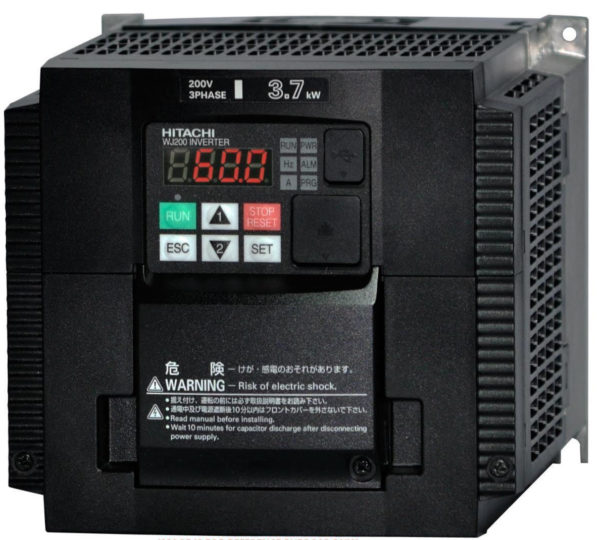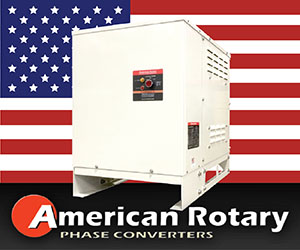So you are the proud owner of a heavy piece of iron with one or more 3-phase motors. Welcome to the club! These machines old and new can represent a great bargain either at auction, or via private sale. Heavy machinery with 3-phase power is difficult to move, and requires a power conversion option if you are moving to a shop without 3-phase power at the panel. Because of these issues, you can get some great deals, if you are willing to take on the task of moving this equipment (sometimes a matter of working “smarter” rather than “harder”) and solving the 3-phase power challenge. In this article, I’ll talk about three different popular options to run 3-phase equipment without 3-phase service to your shop.
Note: You’ll want to read/watch the 3-phase power fundamentals post/video if you haven’t already!
Static Phase Converters
Above: The Phase-A-Matic, a popular static phase converter.
Static phase converters are the simplest and can be the least expensive option to run 3-phase motors from single phase power. They start the motor with “3-phase” power, and then drop to single phase power once the motor has started. Since there are only 2 power legs instead of 3, the motor horsepower runs at a 2/3 horsepower level. Example: A 5hp 3-phase motor is run on a static phase converter- the power level is 2/3 * 5hp = 3.33hp.
Static Phase Converter Pros:
- Simple to wire up
- Inexpensive
Static Phase Converter Cons:
- Runs at reduced power (2/3 of motor rating)
- Motor doesn’t run with the constant rotational speed and torque that you get with true 3-phase power
- Lacks variable speed drive functionality
Rotary Phase Converters
Above: American Rotary AI-series industrial rotary phase converters with NEMA 3R outdoor enclosures
A Rotary Phase Converter takes single phase power in, and uses an “idler motor” combined with capacitors and circuitry to synthesize the “3rd leg” (sometimes called the “wild leg”) which results in true 3-phase power as output. Rotary phase converters are sized by the horsepower of the idler motor, and as a general rule, the rated size of the rotary phase converter is twice the rated motor capacity for equipment run via the rotary phase converter.
Using the American Roatary AI 20 rotary phase converter (RPC) as an example:
- Idler Motor = 20hp. Rated motor start capacity = 10hp.
This is the capacity to start an individual motor. You may be able to support concurrent motor loads well over 1/2 the RPC rating, but this requires consultation with the manufacturer due to the number of variables required to calculate concurrent loads.
In my shop, I have the American Rotary AI 20, and I run the following equipment, all hooked up to a RPC sub panel:
- 1940s Warner Swasey #2 turret lathe with one 3-phase 5hp motor
- 1963 Cincinnati Cinova 80 317-14 horizontal milling machine with 3 3-phase motors (main spindle = 7 1/2 hp, knee motor (~2hp), coolant pump motor (~1/5hp)
- 1942 Kearney and Trecker Milwaukee 2H horizontal milling machine with one 3-phase 5hp motor
- 1940s 1 1/2 hp pedestal grinder (project)
So currently I have a total of six 3-phase motors in the shop. This a a great example of an application for a rotary phase converter. With one investment in the RPC, I can hook up all of my equipment to the RPC as easily as if I had 3-phase coming into the shop from the power pole! Plug and play.
Rotary Phase Converter Pros:
- Inexpensive for multiple motor/machine scenarios
- Easy to install and wire
- Very clean 3-phase power (AI 20 is electronically stabilized)
- Very inexpensive to run, high efficiency
Rotary Phase Converter Cons:
- Can be expensive for single motor scenario (like a table saw)
- Lacks variable speed drive functionality
Variable Frequency Drives
Above: A Hitachi VFD, a popular choice in the industry where quality is important
Variable Frequency Drives are primarily designed for variable speed control of 3-phase motors, including advanced functions like ramp-up and ramp-down, braking, etc. A side benefit of these devices is that they can also convert single phase AC power as input to 3-phase power as output.
In order to properly acquire and setup a VFD you need to:
- Make sure the unit is spec’d and sized appropriately (input power, rated motor capacity, etc)
- Mount the VFD either in the machine, on the exterior of the machine, on a pedestal, or on the wall.
- Wire the VFD to the input power
- Perform wiring tasks for the machinery being powered (in the case of a machine like a modern lathe, this can require several special considerations like safety switches, the jog button, etc)
- Program the VFD
- Optional: Mount a potentiometer for remote speed control
Once installed and programmed, these devices can be like “magic”. One popular application is step pulley type vertical milling machines where you can have both mechanical speed control (belt/pulley position change) as well as variable speed control for the motor itself.
Variable Speed Drive Pros:
- Can be inexpensive for a single motor scenario ($100-300)
- Offers variable speed control, ramp-up/down, braking, reversing
- Small footprint
Variable Speed Drive Cons:
- One VFD needed per motor in general
- Wiring, mounting, and programming complexities
- “VFD noise” when motor is running (you can “hear” the square waves)
- Feedback and harmonics (back to the grid) for motors over approximately 5hp (can require expensive solutions to resolve)
Conclusion
For every 3-phase power conversion need, there’s a good solution. Just like most things in life, there’s no “one size fits all” product for every need. I hope this article helped you understand (at a high level, lots more that could be said here) which power conversion solution is best for your needs.
Please make sure you’re subscribed! I have a lot more related content coming up.
Thanks,
Gavin








